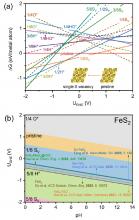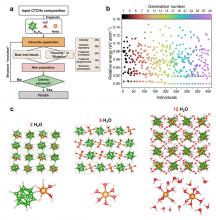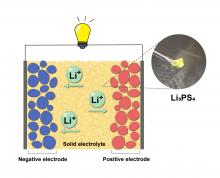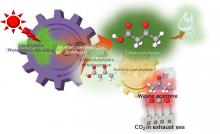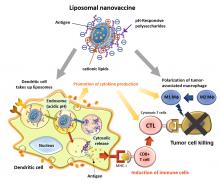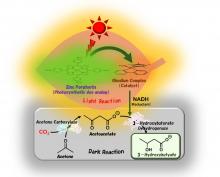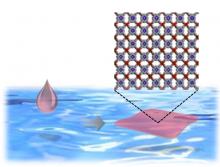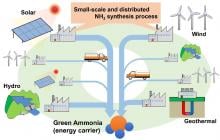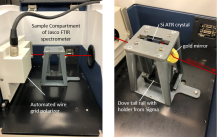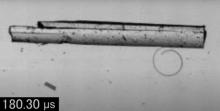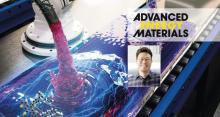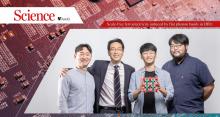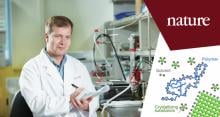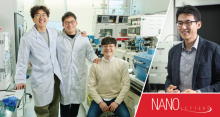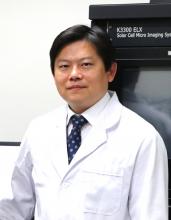Chemistry Chemical engineering
News
22 Mar 2024
The means to synthesize ammonia from nitrogen and hydrogen gas has been around since the early 20th century. Despite its current widespread usage, it has significant environmental drawbacks. Now, researchers from Tohoku University have unveiled a new, environmentally friendly means of producing this widely used chemical.
28 Aug 2023
Solid-state batteries are a safer option that can hold even more energy than current go-to lithium-ion versions, but effectively harnessing their structure-performance relationship has remained a complex barrier to better batteries. Now, however, researchers at Tohoku University’s Advanced Institute for Materials Research in Japan have developed a framework to predict how the structure of solid-state electrolytes can affect the performance of a battery.
03 Aug 2023
Dr. Zhang Yi, the lead scientist, and his team of researchers from Canada, Singapore, the UK, have successfully completed a study, comparing the efficiency of various bioreactors in producing Raspberry Ketone through Submerged Fermentation. This research marks the first time such a study has been conducted.
21 Jun 2023
Osaka Metropolitan University researchers succeeded, for the first time, in stabilizing the high-temperature phase of Li3PS4—a solid electrolyte material¬¬—thus attaining high ionic conductivity even at room temperature, using a method of rapid heating during its crystallization. This unprecedented achievement is expected to contribute to the development of materials for all-solid-state batteries with higher performance.
25 May 2023
A group of researchers from universities in Thailand and Malaysia have collaborated to develop a unique kind of film that is good for the environment and can decompose naturally. They made this film using leftover pineapple stems, which helps reduce the use of harmful plastic films. This new film has the potential to be used as packaging material, contributing to a more sustainable way of doing business and promoting a circular economy.
29 Mar 2023
Osaka Metropolitan University scientists have developed a process using artificial photosynthesis to successfully convert more than 60% of waste acetone into 3-hydroxybutyrate, a material used to manufacture biodegradable plastic. The results were obtained using low-concentration CO2, equivalent to exhaust gas, and powered by light equivalent to sunlight for 24 hours. The researchers expect that this innovative way of producing biodegradable plastic could not only reduce CO2 emissions but also provide a way of reusing laboratory and industrial waste acetone.
24 Mar 2023
An Osaka Metropolitan University joint research group has discovered that near-infrared absorbing dyes, which had previously been considered to have closed-shell electronic structures, have an intermediate electronic structure, between closed- and open-shell structures. They also found that as the wavelength of near-infrared light that can be absorbed becomes longer the contribution of open-shell forms increases within the dye. These newly discovered characteristics are expected to be utilized to develop new near-infrared absorbing dyes that can absorb longer wavelength near-infrared light.
18 Nov 2022
Exploring virtual human-agent relationships, A fly protein gives clue for human cancers, Rare earth elements formed in neutron star mergers 💥, One-stop process for hydrogen production. Read all in the November's Editor's Choice plus Upcoming event K4DM KNOWLEDGE MARKETPLACE – Bangkok 2022: Exchanging Ideas for a Democratic Myanmar.
31 Oct 2022
A research group at Osaka Metropolitan University has developed a drug delivery system that activates a strong cellular immune response to attack cancer cells, using one-tenth of the amount of antigen needed in the group’s previous work. By incorporating positively charged cationic lipids into liposomes and adding negatively charged pH-responsive polysaccharides to the surface, the research group increased the uptake efficiency of liposomes encapsulating cancer antigens by dendritic cells by approximately five times, which increased cytokine production by about 100 times. This increased M1-type macrophages, which activate cancer immunity, and decreased M2-type macrophages, which promote cancer growth.
13 Oct 2022
The project will apply Indonesia’s Institut Teknologi Bandung's (ITB) specialized expertise in chemical reaction engineering to probe optimization of ammonia firing. Target set on achieving cleaner power generation in Indonesia, based on demonstration testing with H-25 gas turbine.
03 Oct 2022
Osaka Metropolitan University scientists have successfully synthesized 3-hydroxybutyrate, a raw material for poly-3-hydroxybutyrate (PHB)—a strong, water-insoluble, biodegradable plastic used for packaging materials—from acetone and CO2. With a visible light-driven catalytic system utilizing sunlight and two biocatalysts, the researchers achieved a high conversion yield of about 80%. Mimicking natural photosynthesis, this study artificially reproduced a light reaction involving sunlight and a dark reaction fixing CO2 to synthesize the raw material for PHB. The finding is expected to contribute to solving the plastic waste problem and to reducing CO2.
28 Jun 2022
Rie Makiura, Associate Professor at the Graduate School of Engineering, Osaka Metropolitan University has published a review article on the facile synthesis of nanosheet materials with precise regular nanoscale pores. In 2010, Professor Makiura’s research group succeeded in fabricating the world's first MOF (metal-organic framework) nanosheets on the surface of water using a simple low-energy process. The procedure, which involved adding drops of suitably chosen molecular components to the water surface took advantage of the same phenomenon that causes the formation of oil films and led to the creation of nanosheets of exceptional integrity and stability. In the present review article, Professor Makiura describes the MOF nanosheets developed by her group so far and provides a detailed description of their characteristics and comparison with other MOF nanosheets reported around the world. In addition, she describes the formation mechanism of the MOF nanosheets on the water surface.
11 Apr 2022
Milling rice to separate the grain from the husks, produces about 100 million tons of rice husk waste globally each year. Scientists searching for a scalable method to fabricate quantum dots have developed a way to recycle rice husks to create the first silicon quantum dot LED light. Their new method transforms agricultural waste into state-of-the-art light-emitting diodes in a low-cost, environmentally friendly way.
14 Feb 2022
Research by Japanese scientists at Hiroshima University reveals a way to make ammonia from its constituent molecules of nitrogen and hydrogen at ambient pressure.
19 Oct 2021
When liquid meets gas, a unique zone forms. Variable by nature, molecules can cross from one state to another, combining in unique ways to either desirable or unwanted ends. From heat escaping a mug of coffee to increasing molecular concentrations in chemical solutions, gas-liquid interfaces are ubiquitous across nature and engineering. But a lack of tools capable of precisely controlling such gas-liquid interfaces limit their applications — until now.
26 Aug 2021
Prof. Jong-Soo Lee, DGIST, succeeded in developing green-emitting Cd-Free quantum dot synthesis technology with high color reproduction capability
02 Aug 2021
The Research Center for Thin Film Solar Cell, DGIST succeeded achieving the world’s highest PCE of 12.2% for flexible CZTS thin film solar cells.
17 Jun 2021
Researchers at Osaka Prefecture University have established an approach to identify the orientation of molecules and chemical bonds in crystalline organic-inorganic hybrid thin films deposited on substrates using Fourier transform infrared spectroscopy (FT-IR) and polarized infrared light with a 3D-printed attenuated total reflectance (ATR) unit. This inexpensive method with laboratory-grade equipment quickly reaches the crystal-structure model of even extremely thin films of less than 10 nm.
19 Apr 2021
Researchers discovered, while exploring the photomechanical properties of diarylethene, that under irradiation with UV light the crystal of the compound peels off into micrometer sized crystals at a world’s fastest speed of 260 microseconds. As the material returns to its former molecular structure when exposed to visible light, the exfoliation method positions itself as a candidate for photoactuator manufacturing.
05 Jan 2021
For the first time, researchers have used a novel catalyst process to recycle a type of plastic found in everything from grocery bags and food packaging to toys and electronics into liquid fuels and wax.
20 Nov 2020
A research team, affiliated with South Korea's Ulsan National Institute of Science and Technology (UNIST) has developed an electrolyte additive (MA-C60) to reduce the problematic behaviors induced by water contamination and the ROS generated from Li‐rich cathodes.
20 Nov 2020
A recent study, affiliated with South Korea's Ulsan National Institute of Science and Technology (UNIST) has unveiled a novel technology that can improve the efficiency of quantum dot solar cells to 11.53% has been unveiled.
19 Nov 2020
A research team, affiliated with South Korea's Ulsan National Institute of Science and Technology (UNIST) has proposed a new physical phenomenon that promises enhanced storage capacity of a fingernail-sized memory chip by 1,000 times.
19 Nov 2020
A recent study, affiliated with South Korea's Ulsan National Institute of Science and Technology (UNIST) has demonstrated that in the presence of polymers (preferably, polyionic liquids), crystals of various types grow in common solvents, at constant temperature, much bigger and much faster when stirred, rather than kept still.
17 Nov 2020
Scientists explain how selective electrostatic doping can balance the charge in optoelectronic devices with 2D materials
03 Nov 2020
A recent study, affiliated with South Korea's Ulsan National Institute of Science and Technology (UNIST) has developed a new nanocatalyst that recycles major greenhouse gases, such as carbon dioxide (CO2) and methane (CH4), into highly value-added hydrogen (H2) gas.
03 Nov 2020
A recent study, affiliated with South Korea's Ulsan National Institute of Science and Technology (UNIST) has unveiled 2D material-based ultrasensitive surface-enhanced Raman spectroscopy (SERS) sensor by synthesizing uniform large-area ReOxSy thin films.

01 Oct 2020
A Hokkaido University research group has successfully demonstrated that carbon-carbon (C-C) covalent bonds expand and contract flexibly in response to light and heat. This unexpected flexibility of C-C bonds could confer new properties to organic compounds.
04 Sep 2020
Scientists at Daegu Gyeongbuk Institute of Science and Technology (DGIST) in Korea have found a way to improve the efficiency of betavoltaic devices, a type of power source that uses an internal radioactive material. This study opens up a new horizon in the field of nuclear batteries for powering set-and-forget electronic devices.
20 Aug 2020
A new catalyst design enables unprecedented control over the modification of fatty acid derivatives that opens the door to creating useful substances in a green and efficient manner.
Events
29 Oct 2019 to 01 Nov 2019
The Singapore International Energy Week (SIEW) is an annual platform for energy professionals, policymakers and commentators to share best practices and solutions within the global energy space.
Researchers
Dr Michinao Hashimoto's research interest is on low-cost device fabrication and their application in point-of-care setting.
Carla Portugal is currently an Assistant Researcher at LAQV-Requimte, NOVA.iD.FCT and is experienced in the development, implementation and monitoring of membrane based processes.
Giants in history
Sorry, nothing coming up for this discipline


